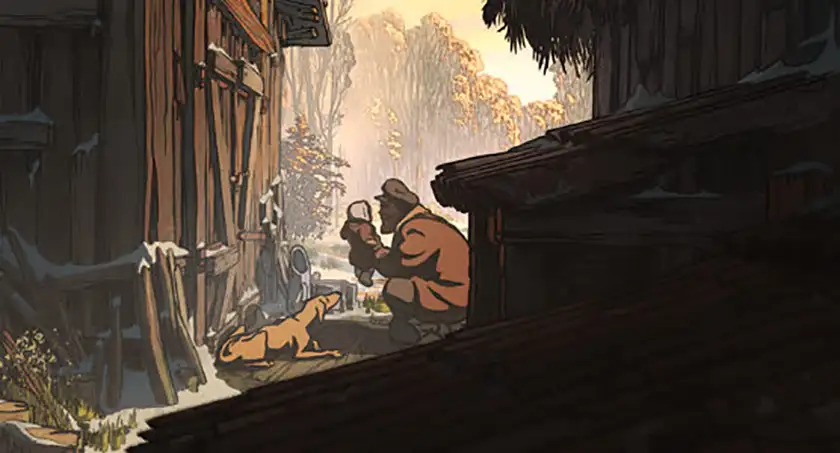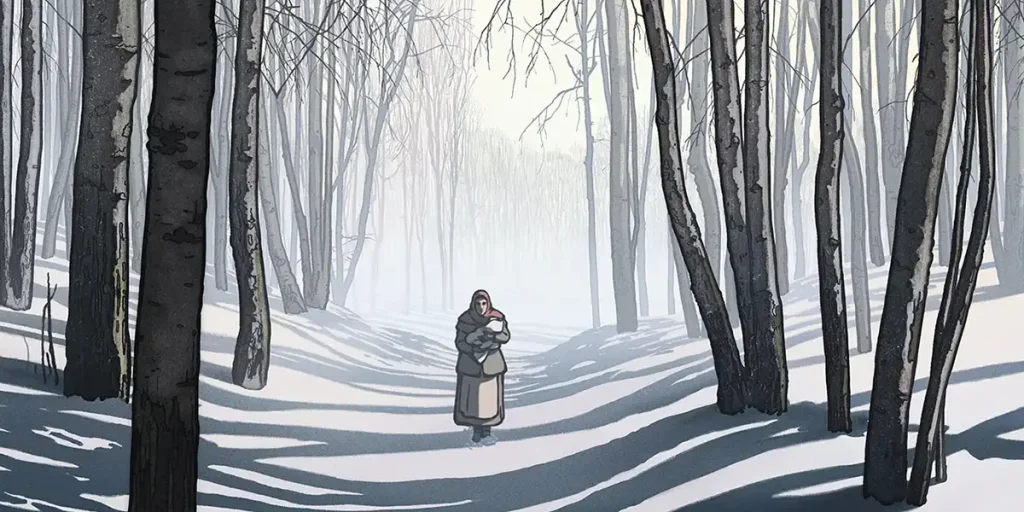The Most Precious of Cargoes (La Plus Précieuse des Marchandises) is an ambitious film that attempts to portray the Holocaust through the lenses of animation.
Director: Michel Hazanavicius
Genre: Animated, Drama, War
Run Time: 81′
U.K. Release: April 4, 2025
U.S. Release: TBA
Where to Watch: In UK & Irish cinemas
The Most Precious of Cargoes (La Plus Précieuse des Marchandises) is based on a novel of the same name by French author Jean-Claude Grumber, who also co-wrote the screenplay. The story begins with a poor woodcutter (Gregory Gadebois) and his wife (Dominique Blanc) in a forest covered by snow, seemingly in the middle of nowhere.
The two are very poor and, as the narrator (Jean-Louis Tintignant) tell us, they’re trying to survive in a country taken over by war. One day, as a train goes by in the forest where they live, the woodcutter’s wife notices that a baby has been thrown off a carriage. Despite her husband’s initial dismay, the couple ends up taking the baby into their homes and caring for her like a daughter. As the movie goes on, the audience also sees the life of the man who threw her off the train and the life that awaits him once the vehicle reaches its destination at the concentration camp where the baby’s father will remain until the place is liberated.
The animation style is fascinating with thick and black strokes painting a world that is not so dissimilar to our own and yet, at the same time, so far from it, especially once it delves into the horrors of the Holocaust. Initially, the audience might have no idea that this is where the film is heading, as the entire first act keeps both the location and the time setting of the story vague. For example, it only refers to the war in general terms at the beginning, so much so that we could almost imagine this story to be about any other conflict and war that we have experienced.
But from the moment The Most Precious of Cargoes shows us the concentration camp, everything becomes more clear. Using animation to portray this is also an interesting choice as it allows the film to show the camps, and all the terrible moments that come with it, without actually filming – and, therefore, virtually recreating – any of that in real life.
The narrative style echoes that of a fairytale from the very beginning, when the voiceover introduces us to a forest covered in snow with the most common beginning of any fable, “once upon a time”. The fact that none of the characters is named – even the protagonists are simply referred to as the woodcutter or the woodcutter’s wife – is also a traditional narrative device typical of fairytales. And yet as we learn more about the story, we quickly realise that this has nothing to do with the whimsical and fantasy dimension fairytales often have, but is instead rooted in real life tragedy. The final voiceover allows us to ponder on the fact that this story might be fictional, but the horrors of the Holocaust remain very real and undeniable.
The idea of borrowing the narrative elements of fairytales is a fascinating one, and it allows The Most Precious of Cargoes to stay true to the book it is based on. However, it does not work for the entirety of the movie. When the two storylines start to intertwine, the film is a lot less successful and almost feels like two separate movies combined into one. The pacing feels similarly odd at times and especially slow in the second act, despite the very compelling story it is attempting to portray.
The soundtrack can also feel too much, and at times exclusively oriented towards manipulating the audience’s feelings towards the movie. This is especially evident in the few sequences in which the movie does not use non diegetic music and relies instead on a much more natural use of sound that privileges the real-life noise of a train moving on the tracks or someone’s footsteps in a forest.
Ultimately, The Most Precious of Cargoes is at its best when it does less. When the music quiets down and the horrors of the Holocaust are merely suggested, rather than shown in detail, the film becomes incredibly powerful. In this sense, it could potentially join the ranks of movies like Jonas Pher Rasmussen’s Flee and Ari Folman’s Waltz with Bashir in the way it uses the genre of adult animation to depict horrors we cannot bear seeing on screen. However, this film does not quite reach the same level of compelling argument and commentary that the two documentaries have. In many ways, it is instead a film frozen in the fairytale time it establishes at the very beginning, remaining too disconnected from the reality it may – and perhaps should – wish to comment on.

I wish The Most Precious of Cargoes had done more with such a strong and original premise, but it is still a fascinating film that once again proves how animation is a powerful medium that can be used to portray many different things, despite its usual association with children’s movies and stories that might be less grounded in reality. Overall, the movie is original, if only not bold enough to make a lasting impact on an audience that is familiar with both the subject matter and the relatively innovative narrative and visual style it employs to portray it.
The Most Precious of Cargoes (La Plus Précieuse des Marchandises): Movie Plot & Recap
Synopsis:
One day, a woodcutter’s wife finds a baby girl who was thrown from one of a trains and can’t help but rescue her and take her into their home. But why was she thrown from a train and what awaits those who do not share her same fate and reach their dreadful destination?
Pros:
- The film’s narration lets the audience go back to a fairytale dimension and successfully combines this with more realistic elements.
- The animation is beautiful and manages to evoke powerful feelings and themes.
Cons:
- The film’s structure is often lacking with the two storylines struggling to come together and a weak pacing that makes its runtime feel a lot longer than it is.
- The soundtrack is very imposing and at times feels manipulative of the audience’s feelings.
The Most Precious of Cargoes (La Plus Précieuse des Marchandises) will be released in UK & Irish cinemas on 4 April, 2025 by StudioCanal.

